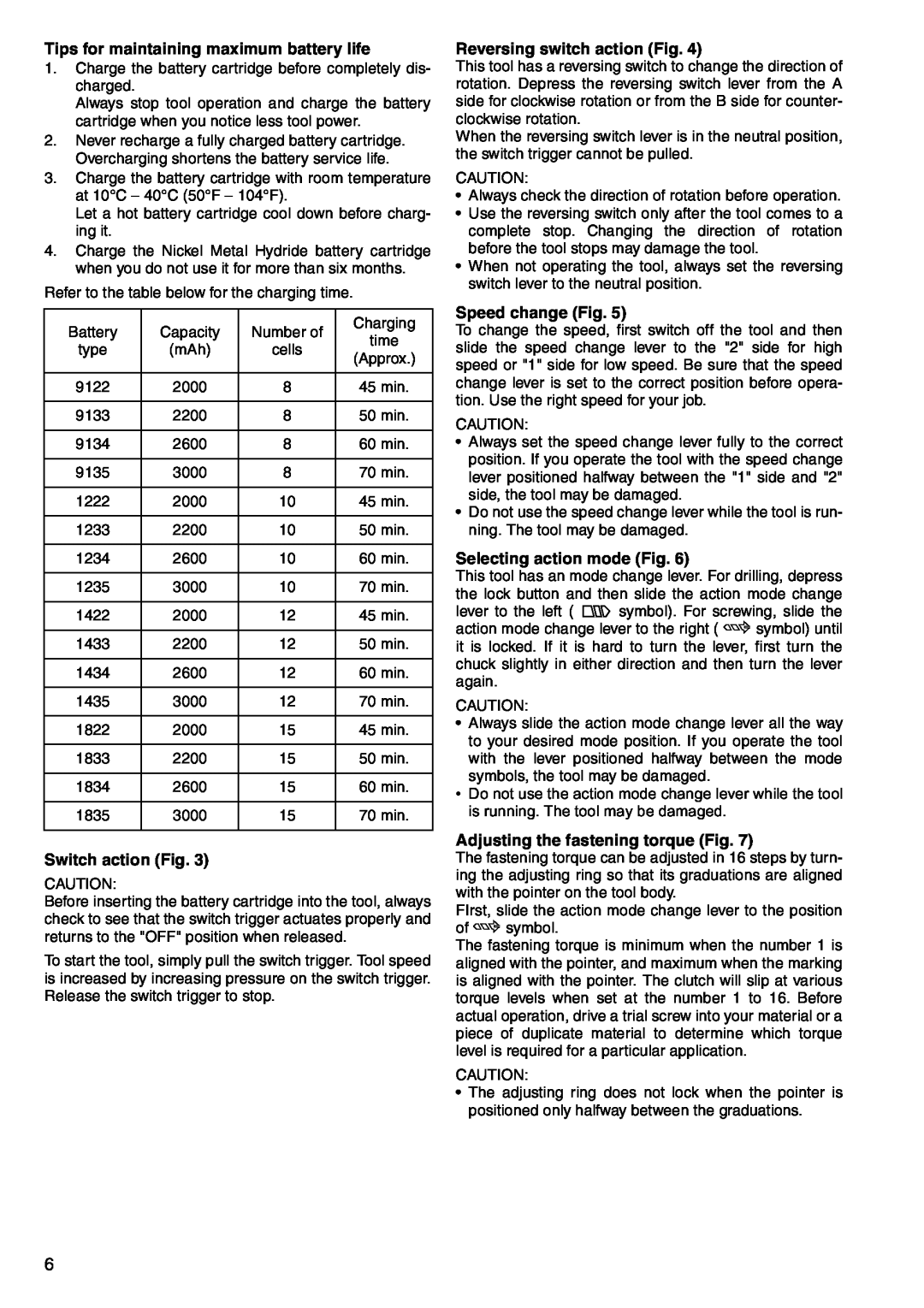Tips for maintaining maximum battery life
1.Charge the battery cartridge before completely dis- charged.
Always stop tool operation and charge the battery cartridge when you notice less tool power.
2.Never recharge a fully charged battery cartridge. Overcharging shortens the battery service life.
3.Charge the battery cartridge with room temperature at 10°C – 40°C (50°F – 104°F).
Let a hot battery cartridge cool down before charg- ing it.
4.Charge the Nickel Metal Hydride battery cartridge when you do not use it for more than six months.
Refer to the table below for the charging time.
Battery | Capacity | Number of | Charging | |
time | ||||
type | (mAh) | cells | ||
(Approx.) | ||||
|
|
| ||
|
|
|
| |
9122 | 2000 | 8 | 45 min. | |
|
|
|
| |
9133 | 2200 | 8 | 50 min. | |
|
|
|
| |
9134 | 2600 | 8 | 60 min. | |
|
|
|
| |
9135 | 3000 | 8 | 70 min. | |
|
|
|
| |
1222 | 2000 | 10 | 45 min. | |
|
|
|
| |
1233 | 2200 | 10 | 50 min. | |
|
|
|
| |
1234 | 2600 | 10 | 60 min. | |
|
|
|
| |
1235 | 3000 | 10 | 70 min. | |
|
|
|
| |
1422 | 2000 | 12 | 45 min. | |
|
|
|
| |
1433 | 2200 | 12 | 50 min. | |
|
|
|
| |
1434 | 2600 | 12 | 60 min. | |
|
|
|
| |
1435 | 3000 | 12 | 70 min. | |
|
|
|
| |
1822 | 2000 | 15 | 45 min. | |
|
|
|
| |
1833 | 2200 | 15 | 50 min. | |
|
|
|
| |
1834 | 2600 | 15 | 60 min. | |
|
|
|
| |
1835 | 3000 | 15 | 70 min. | |
|
|
|
|
Switch action (Fig. 3)
CAUTION:
Before inserting the battery cartridge into the tool, always check to see that the switch trigger actuates properly and returns to the "OFF" position when released.
To start the tool, simply pull the switch trigger. Tool speed is increased by increasing pressure on the switch trigger. Release the switch trigger to stop.
Reversing switch action (Fig. 4)
This tool has a reversing switch to change the direction of rotation. Depress the reversing switch lever from the A side for clockwise rotation or from the B side for counter- clockwise rotation.
When the reversing switch lever is in the neutral position, the switch trigger cannot be pulled.
CAUTION:
•Always check the direction of rotation before operation.
•Use the reversing switch only after the tool comes to a complete stop. Changing the direction of rotation before the tool stops may damage the tool.
•When not operating the tool, always set the reversing switch lever to the neutral position.
Speed change (Fig. 5)
To change the speed, first switch off the tool and then slide the speed change lever to the "2" side for high speed or "1" side for low speed. Be sure that the speed change lever is set to the correct position before opera- tion. Use the right speed for your job.
CAUTION:
•Always set the speed change lever fully to the correct position. If you operate the tool with the speed change lever positioned halfway between the "1" side and "2" side, the tool may be damaged.
•Do not use the speed change lever while the tool is run- ning. The tool may be damaged.
Selecting action mode (Fig. 6)
This tool has an mode change lever. For drilling, depress the lock button and then slide the action mode change lever to the left ( f symbol). For screwing, slide the action mode change lever to the right ( Usymbol) until it is locked. If it is hard to turn the lever, first turn the chuck slightly in either direction and then turn the lever again.
CAUTION:
•Always slide the action mode change lever all the way to your desired mode position. If you operate the tool with the lever positioned halfway between the mode symbols, the tool may be damaged.
•Do not use the action mode change lever while the tool is running. The tool may be damaged.
Adjusting the fastening torque (Fig. 7)
The fastening torque can be adjusted in 16 steps by turn- ing the adjusting ring so that its graduations are aligned with the pointer on the tool body.
FIrst, slide the action mode change lever to the position of Usymbol.
The fastening torque is minimum when the number 1 is aligned with the pointer, and maximum when the marking is aligned with the pointer. The clutch will slip at various torque levels when set at the number 1 to 16. Before actual operation, drive a trial screw into your material or a piece of duplicate material to determine which torque level is required for a particular application.
CAUTION:
•The adjusting ring does not lock when the pointer is positioned only halfway between the graduations.
6
